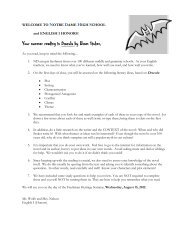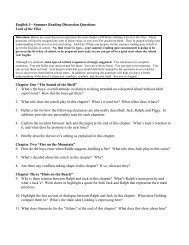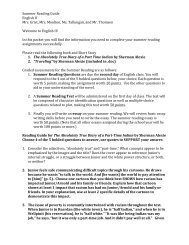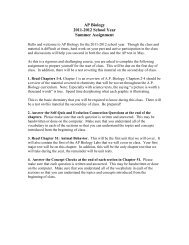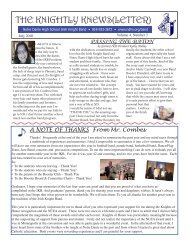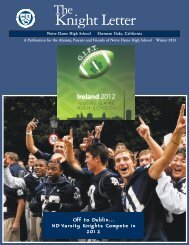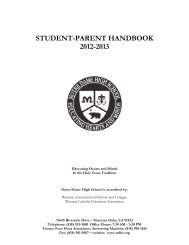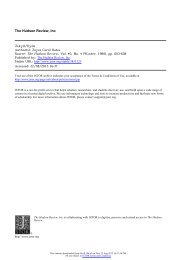Create successful ePaper yourself
Turn your PDF publications into a flip-book with our unique Google optimized e-Paper software.
<strong>AP</strong> <strong>European</strong> <strong>History</strong> Summer Reading 2011<br />
Mr. Savage<br />
savage@ndhs.org<br />
818-933-3663<br />
Greetings. I look forward to our study of history together next year. This will be an<br />
endeavor worth the work and preparation over this summer vacation.<br />
There are four components to your summer reading: you need not do these in the<br />
order that they appear here:<br />
I. Read The Praise of Folly by Desiderius Erasmus<br />
II. Read What Is <strong>History</strong> by Edward Hallett Carr<br />
III. Visit the Getty Hilltop (the one off the 405) for their exhibit Paris – Life and<br />
Luxury which is running until August 7, 2011.<br />
IV. Read the textbook: “Introduction – The West Before 1300”, Chapter 9 – “The<br />
Late Middle Ages” and Chapter 10 – “Renaissance and Discovery”<br />
V. Map Review – found in the assignment packet.<br />
Key to Summer Reading: Be an active reader.<br />
An active reader anticipates, makes connections, and draws conclusions while reading a text—<br />
avoiding the dreaded situation where you reach the end of a chapter or page and think “what did I<br />
just read” This summer is the time for you to train to be an active reader. You will be reading<br />
college-level material and it will not easy. If you cannot handle the textbook over the summer, it<br />
will be incredibly difficult to handle it when you have six other classes to worry about. Therefore,<br />
spend the time this summer to work slowly and develop habits so that you can master the<br />
difficult language and ideas presented in these books.<br />
Remember, as you read these texts, you are reading to learn. You are NOT just reading to get<br />
through this and answer some questions. You should be able to explain what you have read once<br />
you get to the bottom of each page or the end of each chapter.<br />
To make sure you are being an attentive, active reader, you should be asking yourself these<br />
questions while reading:<br />
• Do I know anything about this event, idea, or person (Have I ever heard of this)<br />
• How does this connect to other topics that precede it<br />
• Why is this important (Why is it included) How does this affect other things in history<br />
• After reading about an event, idea, or person: What do I need to remember<br />
As you are reading, I encourage you to take notes in the margins of your texts that summarize<br />
the main ideas or draw attention to a topic of interest.<br />
Here are some other possible techniques you might consider to ensure you comprehend the text:<br />
• Use a highlighter or a pen to underline major terms or sentences (avoid overhighlighting)<br />
• Write a sentence after each paragraph or page summarizing main idea<br />
• Write a question after each paragraph that you can use to quiz yourself after you are done<br />
reading the section
• Pay attention to the subject headings and bold terms—<br />
• Have a dictionary handy to look up any tough vocabulary words<br />
• Struggling to understand something Look it up on the internet—it might be explained<br />
differently or have visuals that may help you understand<br />
• Summarize a section aloud after you have read it—if you can’t explain it in your own<br />
words, then you don’t really comprehend what the section is about<br />
Assignment I – The Praise of Folly<br />
ISBN 9780300023732<br />
This book is a classic of Renaissance literature and Christian humanism. Christian<br />
humanism was a school of thought during the Renaissance that believed the best<br />
development of the individual toward God was through education in the classics and<br />
Christian education.<br />
Erasmus wrote The Praise of Folly at an important time in <strong>European</strong> history: the height<br />
of the Inquisition and the beginning of the end of the scholastic movement in Catholic<br />
theology. Interestingly, he was not called in for questioning by the Inquisition nor<br />
censored by the Holy Roman Emperor Charles V.<br />
Assignment: Write a letter/correspondence to Erasmus in the person of Sir Thomas<br />
More (you might want to research a little in More’s background). In your letter<br />
address what you consider to be Erasmus’ strengths and weaknesses of argument,<br />
but especially try to match his wit and humor which was a prized trait in the<br />
Renaissance. If you were More would you be pleased with such a work dedicated to<br />
you, and if so what type of person must More have been Be creative and try to get<br />
into the spirit of their times – life was good then but still had some ways to go and<br />
problems to overcome. Your letter need not be exhaustive - two pages, double<br />
spaced typed, will be sufficient. This will be handed in at the beginning of the<br />
semester.<br />
Assignment II – What Is <strong>History</strong><br />
ISBN 039470391X<br />
Carr’s book is a collection of lectures he delivered at Cambridge between January and<br />
March 1961. When you consider what was happening in the world in 1961 you can<br />
appreciate Carr’s question, “What is history” The year 1961 saw<br />
‣ the Vatican II Council in the Catholic Church underway, a major change in an<br />
institution that hadn’t changed since the Council of Trent in the 16 th century<br />
‣ the Cold War in full swing as the Cuban Missile Crisis loomed on the horizon and<br />
Communism made in-roads into Southeast Asia.<br />
‣ the beginning of the stories told by Holocaust survivors who had not told of their<br />
experiences beforehand. In 1961 Adolf Eichmann went on trial in Israel after<br />
being hunted down and captured in Argentina – part of his trial was the testimony<br />
of survivors of Auschwitz who had not related those events to any before, not<br />
even their families.<br />
So you can understand why Carr’s question was appropriate then and is important for us<br />
today: 2011/2012 will mark the ten year anniversary of the September 11 terrorist attack,
the re-election process of the first black president in American history, the democracy<br />
movements in North Africa and the Middle East, the increased strength of the Asian<br />
economic market, and the digitizing of whole library collections from major universities<br />
in the world.<br />
Assignment: Create a graphic organizer of What Is <strong>History</strong> by focusing on what<br />
you take to be Carr’s main point and his support for it in each chapter/lecture. The<br />
organizer can be created in such a way that it can be easily referenced by you<br />
during the school year as we consider Carr’s theories in light of the periods we<br />
study. Each graphic organizer should take up about half of a page in a binder or<br />
notebook. This will not be handed in.<br />
Assignment III – Getty exhibit Paris – Life and Luxury<br />
The Getty is one of my favorite places for an evening with friends. I often go to see my<br />
favorite painting by Goya, La Marquesa de Santiago, or the Impressionist/Expressionist<br />
rooms to see the works of Monet and Degas. If you go on Saturday evening after 5PM<br />
parking is free – the restaurants are of fantastic quality and the picnic grounds are<br />
beautiful for a light sandwich or salad.<br />
The exhibit focuses on the rise of luxury home goods in Paris from the 18 th century. One<br />
thing you will notice is the tendency to include household items in painted portraits of<br />
individuals – these were usually included to give clues as to the occupation of the person.<br />
Assignment: Create a guide to the exhibit for hypothetical visitors to the Getty with<br />
limited time and only a rudimentary exposure to French history. The guide should<br />
be such that they could rush in to the museum, pick it up from you, follow your<br />
directions, and come out with a better grasp of their time and life. Therefore, you<br />
will not detail every single object because your hypothetical guests only have a short<br />
time – instead tell them what to see in a short time and why. This will be handed in<br />
at the beginning of the semester.<br />
Assignment IV – the textbook reading<br />
Kagan, Donald, Steven Ozment and Frank Turner. The Western Heritage: Since 1300 <strong>AP</strong> Edition<br />
(Ninth Edition). Upper Saddle River, NJ: Pearson-Prentice Hall, 2007.<br />
Assignment: Read and take notes on the Introduction, Chapter 9, and part of Chapter 10.<br />
Note on taking notes:<br />
• Use subject headings as a guide to what you are reading<br />
• Add to your notes the main ideas in each of these sections, as well as historical examples<br />
that back up this main idea. Example:<br />
o Main idea: “Little medical knowledge made people resort to strange remedies for<br />
the plague.”<br />
o Historical example: “ex. Boccaccio’s Decameron describe people turning to<br />
temperance or sexual promiscuity, ex. Flagellants—beat themselves for peasants”
I. Introduction: "The West Before 1300"<br />
It is optional to read the first part of this introductory section of the book. This is a<br />
quick overview of antiquity and therefore should cover material with which you<br />
should already be familiar (Hebrews, Greeks, Romans).<br />
Required:<br />
Read pages xlii-xlvi, examining the Greek polis, Sparta, Athens, and Greek political<br />
philosophy.<br />
Read pages lvii-lxxvii, "Decline and Fall of the Roman Empire" and "Europe Enters<br />
the Middle Ages." Take notes on the following terms<br />
Byzantine Empire<br />
• Charlemagne<br />
• Feudal society (including 'vassalage' and 'fief')<br />
• Manorialism ('manors')<br />
• Serfdom<br />
• Division of Christendom: West and East<br />
• Towns: burghers (bourgeois)<br />
• Crusades<br />
• "Emerging Contours of Europe"<br />
(continued)<br />
II. Chapter 9: "The Late Middle Ages"<br />
This chapter focuses on three major “crises” in the Late Middle Ages: the Black<br />
Death, the Hundred Years War, and the Schism in the Church. The following is a<br />
rough outline that you should follow when taking notes on the section:<br />
a. Black Death:<br />
i. Causes<br />
ii. Remedies<br />
iii. Consequences:<br />
1. Farms<br />
2. Peasants<br />
3. Cities<br />
4. Long-term effects (“new conflicts and opportunities”)<br />
b. The Hundred Years’ War<br />
i. Causes<br />
ii. Progress:<br />
1. English victories<br />
2. Joan of Arc and the War’s Conclusion<br />
iii. Consequences
c. Ecclesiastical Breakdown—for this section, write a short-answer question that<br />
encapsulates the central meaning of the section (this should not be a “yes” or<br />
“no” question but should require a multi-sentence of multi-paragraph answer).<br />
Then, take notes beneath this question in a manner that provides evidence to<br />
answer the question<br />
i. The Thirteenth-Century Papacy<br />
ii. Boniface VIII and Philip the Fair<br />
iii. The Avignon Papcy<br />
iv. John Wycliff and John Huss<br />
v. The Great Schism (1378-1417) and the Conciliar Movement to 1449<br />
d. Medieval Russia: take brief notes on this section<br />
III. Chapter 10: "Renaissance and Discovery"<br />
Read the first part of this chapter, "The Renaissance in Italy," pp. 316-331.<br />
Take notes on this section as well, using subject headings as a guide, and<br />
continuing to find the main idea of the sections as well as historical examples<br />
that back up the main ideas.<br />
Assignment V – Map Review<br />
Examine a map of Europe (see attached or find one online). You will have a map quiz on the first<br />
day of class. Be able to locate on the map the following terms:<br />
V. Map<br />
Countries & Major Cities:<br />
Portugal<br />
Lisbon<br />
Spain<br />
Madrid*<br />
Barcelona<br />
France<br />
Paris*<br />
Vichy<br />
Avignon<br />
Luxembourg<br />
Belgium<br />
Brussels<br />
Netherlands<br />
The Hague<br />
Amsterdam<br />
Rotterdam<br />
United Kingdom:<br />
England<br />
London*<br />
Manchester<br />
Scotland<br />
Edinburgh<br />
Wales<br />
Northern Ireland<br />
Belfast<br />
Countries & Major Cities:<br />
Czech Republic (formerly<br />
Bohemia)<br />
Prague<br />
Slovakia<br />
Poland<br />
Warsaw<br />
Krakow<br />
Gdansk<br />
Lithuania<br />
Latvia<br />
Estonia<br />
Hungary<br />
Budapest<br />
Croatia<br />
Zagreb<br />
Serbia<br />
Belgrade<br />
Montenegro<br />
Bosnia-Herzegovina<br />
Sarajevo<br />
Albania<br />
Republic of Macedonia<br />
Greece<br />
Athens<br />
Turkey<br />
Bodies of Water:<br />
Baltic Sea<br />
North Sea<br />
English Channel<br />
Bay of Biscay<br />
Strait of Gibraltar<br />
Mediterranean Sea<br />
Aegean Sea<br />
Dardanelles & Bosphorus Straits<br />
Black Sea<br />
Caspian Sea<br />
Adriatic Sea<br />
Ionian Sea<br />
Rivers:<br />
Elbe<br />
Tiber<br />
Danube<br />
Seine<br />
Mountains:<br />
Pyranees<br />
Alps<br />
Caucasus<br />
Carpathians<br />
Urals<br />
Thames<br />
Oder<br />
Volga<br />
Rhine
Ireland<br />
Dublin<br />
Germany<br />
Frankfurt<br />
Berlin*<br />
Munich<br />
Dresden<br />
Bonn<br />
Nuremburg<br />
Austria<br />
Vienna*<br />
Switzerland<br />
Zurich<br />
Geneva<br />
Bern<br />
Italy<br />
Rome*<br />
Venice<br />
Florence<br />
Naples<br />
Milan<br />
Turin<br />
Slovenia<br />
*denotes major political capital<br />
Istanbul (Constantinople)<br />
Bulgaria<br />
Sofia<br />
Romania<br />
Bucharest<br />
Moldova<br />
Ukraine<br />
Kiev<br />
Belarus<br />
Russian Federation<br />
Kaliningrad<br />
Moscow*<br />
St.<br />
Petersburg/Leningrad*<br />
Volgograd (Stalingrad)<br />
Finland<br />
Helsinki<br />
Sweden<br />
Stockholm<br />
Norway<br />
Oslo<br />
Denmark<br />
Copenhagen<br />
*denotes major political capital<br />
Balkans<br />
Islands:<br />
Crete<br />
Sicily<br />
Sardinia<br />
Corsica<br />
Areas in Holy Roman<br />
Empire:**<br />
Silesia<br />
Moravia<br />
Palatinate<br />
Saxony<br />
Brandenburg<br />
Bavaria<br />
Westphalia-Ruhr<br />
Alsace-Lorraine<br />
**see map on p. lxxiii or p. 408<br />
Other Areas:<br />
Brittany Peninsula<br />
Crimea<br />
Iberian Peninsula<br />
Balkans<br />
Ruhr Valley<br />
Can you identify all the countries on this map of Europe<br />
MODERN EUROPE M<strong>AP</strong> (BLANK)
Map with most names and terms:<br />
MODERN EUROPE M<strong>AP</strong>



